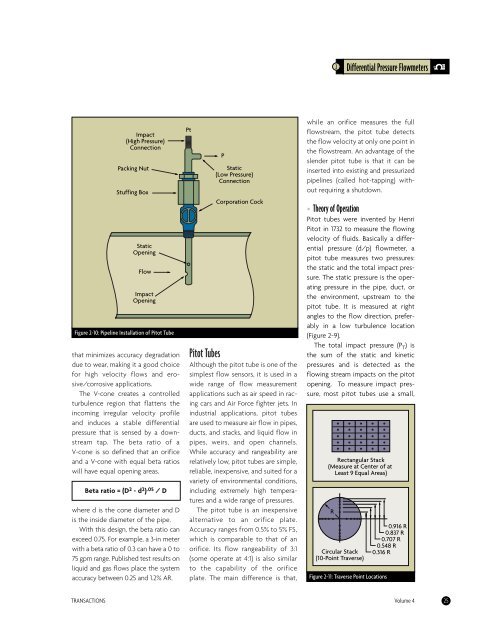flow and level measurement - Omega Engineering
flow and level measurement - Omega Engineering
flow and level measurement - Omega Engineering
Create successful ePaper yourself
Turn your PDF publications into a flip-book with our unique Google optimized e-Paper software.
Impact<br />
(High Pressure)<br />
Connection<br />
Packing Nut<br />
Stuffing Box<br />
Static<br />
Opening<br />
Flow<br />
Impact<br />
Opening<br />
Figure 2-10: Pipeline Installation of Pitot Tube<br />
that minimizes accuracy degradation<br />
due to wear, making it a good choice<br />
for high velocity <strong>flow</strong>s <strong>and</strong> erosive/corrosive<br />
applications.<br />
The V-cone creates a controlled<br />
turbulence region that flattens the<br />
incoming irregular velocity profile<br />
<strong>and</strong> induces a stable differential<br />
pressure that is sensed by a downstream<br />
tap. The beta ratio of a<br />
V-cone is so defined that an orifice<br />
<strong>and</strong> a V-cone with equal beta ratios<br />
will have equal opening areas.<br />
Beta ratio = (D 2 - d 2 ) .05 / D<br />
where d is the cone diameter <strong>and</strong> D<br />
is the inside diameter of the pipe.<br />
With this design, the beta ratio can<br />
exceed 0.75. For example, a 3-in meter<br />
with a beta ratio of 0.3 can have a 0 to<br />
75 gpm range. Published test results on<br />
liquid <strong>and</strong> gas <strong>flow</strong>s place the system<br />
accuracy between 0.25 <strong>and</strong> 1.2% AR.<br />
Pt<br />
P<br />
Static<br />
(Low Pressure)<br />
Connection<br />
Corporation Cock<br />
Pitot Tubes<br />
Although the pitot tube is one of the<br />
simplest <strong>flow</strong> sensors, it is used in a<br />
wide range of <strong>flow</strong> <strong>measurement</strong><br />
applications such as air speed in racing<br />
cars <strong>and</strong> Air Force fighter jets. In<br />
industrial applications, pitot tubes<br />
are used to measure air <strong>flow</strong> in pipes,<br />
ducts, <strong>and</strong> stacks, <strong>and</strong> liquid <strong>flow</strong> in<br />
pipes, weirs, <strong>and</strong> open channels.<br />
While accuracy <strong>and</strong> rangeability are<br />
relatively low, pitot tubes are simple,<br />
reliable, inexpensive, <strong>and</strong> suited for a<br />
variety of environmental conditions,<br />
including extremely high temperatures<br />
<strong>and</strong> a wide range of pressures.<br />
The pitot tube is an inexpensive<br />
alternative to an orifice plate.<br />
Accuracy ranges from 0.5% to 5% FS,<br />
which is comparable to that of an<br />
orifice. Its <strong>flow</strong> rangeability of 3:1<br />
(some operate at 4:1) is also similar<br />
to the capability of the orifice<br />
plate. The main difference is that,<br />
2 Differential Pressure Flowmeters<br />
while an orifice measures the full<br />
<strong>flow</strong>stream, the pitot tube detects<br />
the <strong>flow</strong> velocity at only one point in<br />
the <strong>flow</strong>stream. An advantage of the<br />
slender pitot tube is that it can be<br />
inserted into existing <strong>and</strong> pressurized<br />
pipelines (called hot-tapping) without<br />
requiring a shutdown.<br />
• Theory of Operation<br />
Pitot tubes were invented by Henri<br />
Pitot in 1732 to measure the <strong>flow</strong>ing<br />
velocity of fluids. Basically a differential<br />
pressure (d/p) <strong>flow</strong>meter, a<br />
pitot tube measures two pressures:<br />
the static <strong>and</strong> the total impact pressure.<br />
The static pressure is the operating<br />
pressure in the pipe, duct, or<br />
the environment, upstream to the<br />
pitot tube. It is measured at right<br />
angles to the <strong>flow</strong> direction, preferably<br />
in a low turbulence location<br />
(Figure 2-9).<br />
The total impact pressure (P T ) is<br />
the sum of the static <strong>and</strong> kinetic<br />
pressures <strong>and</strong> is detected as the<br />
<strong>flow</strong>ing stream impacts on the pitot<br />
opening. To measure impact pressure,<br />
most pitot tubes use a small,<br />
Rectangular Stack<br />
(Measure at Center of at<br />
Least 9 Equal Areas)<br />
Circular Stack<br />
(10-Point Traverse)<br />
Figure 2-11: Traverse Point Locations<br />
0.916 R<br />
0.837 R<br />
0.707 R<br />
0.548 R<br />
0.316 R<br />
TRANSACTIONS Volume 4 25<br />
R

















